Key words
Human Papilloma Virus, Vaccination, Knowledge, women
Introduction
Despite the progress in cancer prevention strategies, the cervical cancer remains a significant public health issue [1,2]. The screening test used for many years is the Papanikolaou test, which made the secondary prevention possible. Primary prevention is now also achievable with the introduction of vaccination against Human Papilloma Virus (HPV), which is responsible fro 99.7 % of cervical cancer cases worldwide. Two safe and efficient vaccines have been in use for over a decade [3,4].
Health professionals knowledge of the screening and diagnostic procedures is a key factor for women’s participation in prevention programs. However , the rapid development of the vaccines has not been associated with a proportionate increase in the knowledge regarding the pathophysiology of cervical cancer, its association with HPV and the efficacy of vaccination [5,6]. Moreover, women still ignore basic information regarding the cervical cancer and its prevention capabilities and women- health professionals seem to be no exception to that [7]. The lack of information, negligence and fear ,even among health professionals, together with limited access to health services in rural areas, are significant reasons, for failure of the pre-symptomatic testing procedures, as they lead less and less women to do the test [8,9].
The purpose of this study was to present a comparative assessment of the attitudes and knowledge of women - health professionals and women of general population regarding the Pap test and the receptivity to HPV vaccination , as recorded in two previous studies [10-12].
METHODOLOGY
The present study compared data of two previous studies regarding the receptivity to HPV vaccination and Pap test knowledge of women health professionals and women of general population in Greek Province areas. The first study included 100 adult women aged 18-65 years old and it was conducted in towns of central and southern Greece. The second one included 151 women aged 22-65 health professionals, both doctors and nurses, working in a provincial hospital of central Greece. The tool of the studies was a questionnaire which included 66 closed-type questions and referred to the knowledge the women have regarding the prevention of the cervical cancer, the Pap test, the HPV virus, as well as their attitude to vaccinating themselves and their children, previously used in the bibliography. Every woman gave in written her consent for the participation in the research and filled in anonymously the questionnaire, in the presence of some members of the research group.
Statistical analysis
Descriptive statistics were applied and contingency tables were created on the general epidemiological characteristics of the samples. XC2 test, along with Yates’ correction was used to compare rates between the two groups. Significance was considered at 0.05 level.The statistical process was conducted with SPSS for Windows, 13.0v.
Results
Regarding the health professionals sample (Group A), 136 (90%) of the participants were also 25-40 years old. Regarding their place of residence and their family income, 98 (65%) lived in a town and 98 (65%) had a monthly family income < 2000 euros.
Regarding their educational level 90 (59.6%) were tertiary education graduates, while 50 (33.1%) were high school graduates. In the general population sample (Group B), 90 (90%) women in general population sample were 20-45 years old and 10 (10%) were above 46 years. Regarding their educational level, 53 (53%) were high school graduates, while 19 (19%) Tertiary Education Graduates. 21 (21%) were junior high school graduates and 7 (7%) were elementary school graduates. Regarding their place of residence and their family income , 41 (41%) lived in a town and 64% had a monthly family income < 2000 euros. (Table 1). A statistically significant larger percentage of health professionals (127/140, 90.7%) had conducted the Pap test, at least once in a lifetime, in comparison with the general population (79/100,79%), p<0.05. (Table 2). Women in both groups were receptive to their offspring’s vaccination, with health professionals being statistically significantly more receptive. 119/145 (82%) women in Group A were receptive to daughter’s HPV vaccination, while 62/98 (63.2%) in Group B did so. 114/145 (78.6%) women in Group A were receptive to son’s HPV, vs 61/98 (62.2%) in Group B (Table 4).
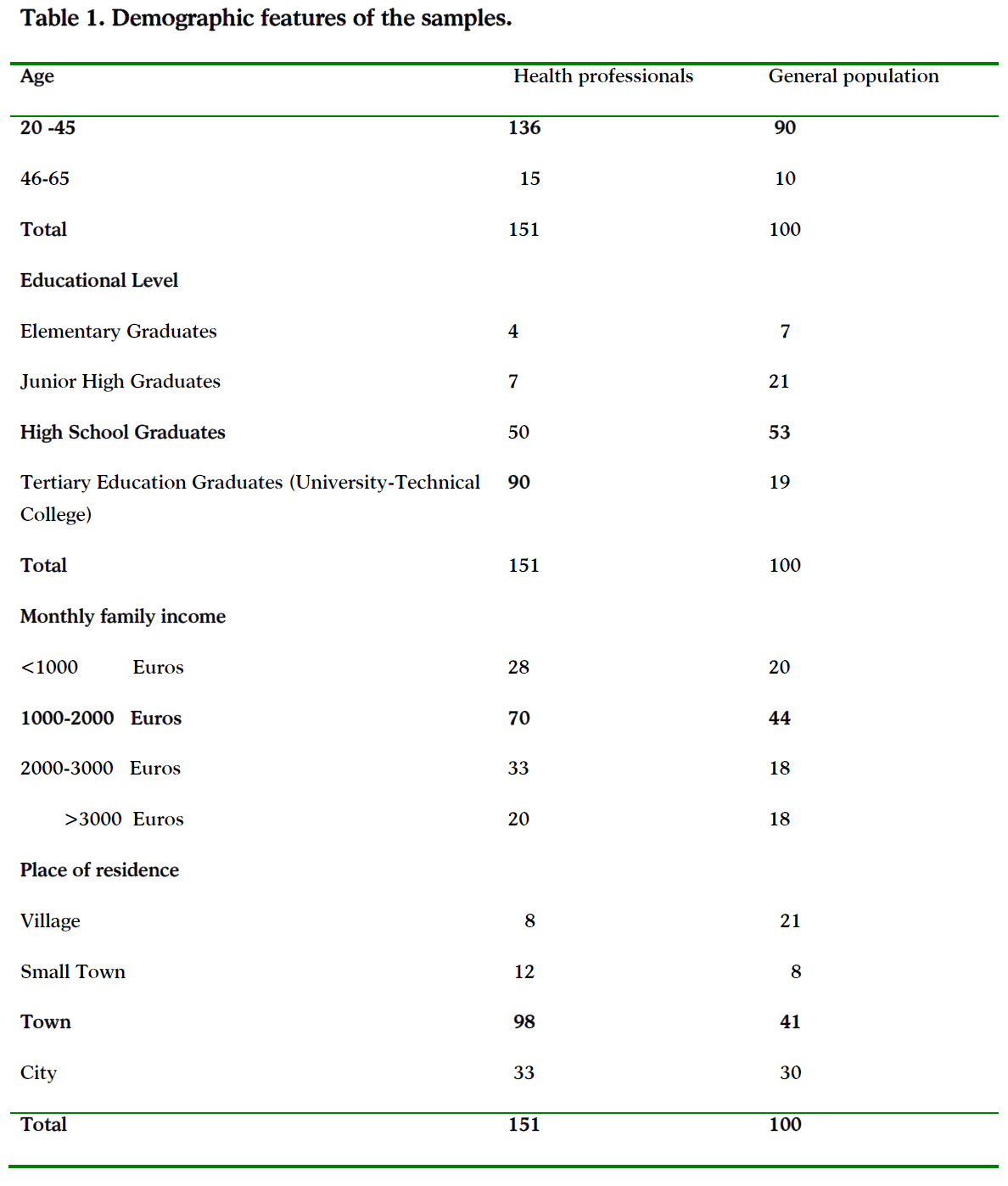
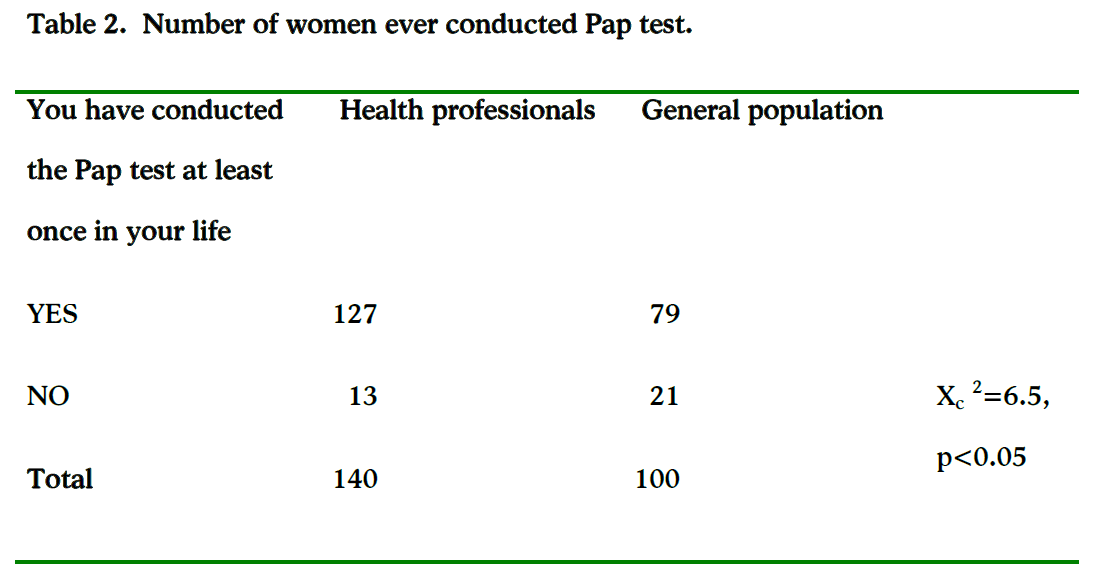
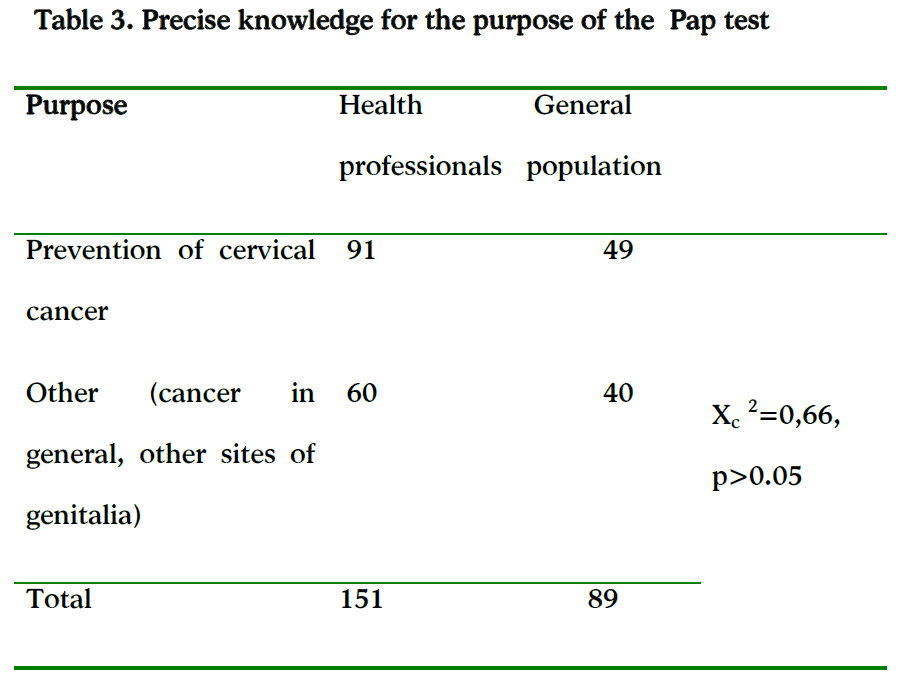
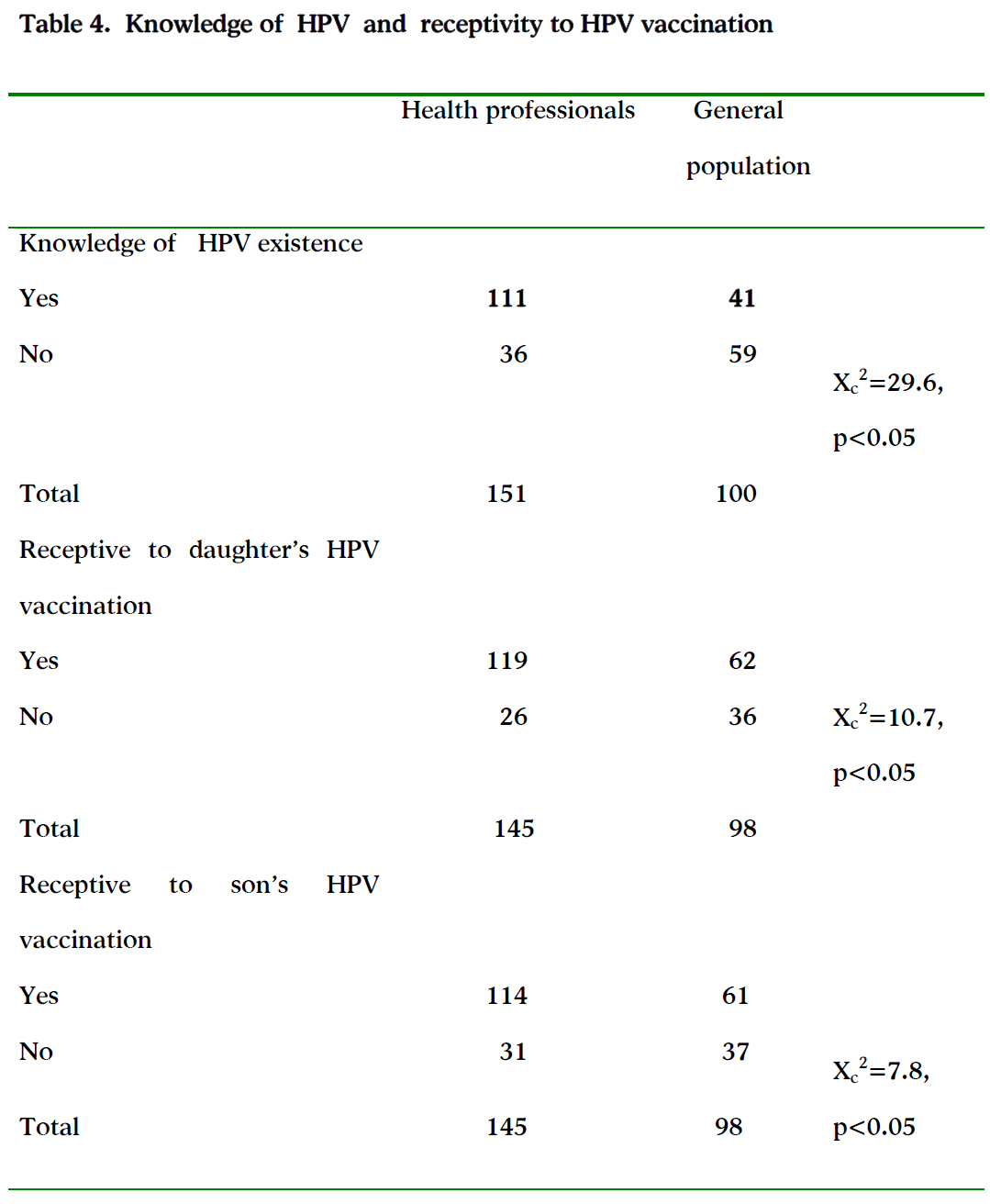
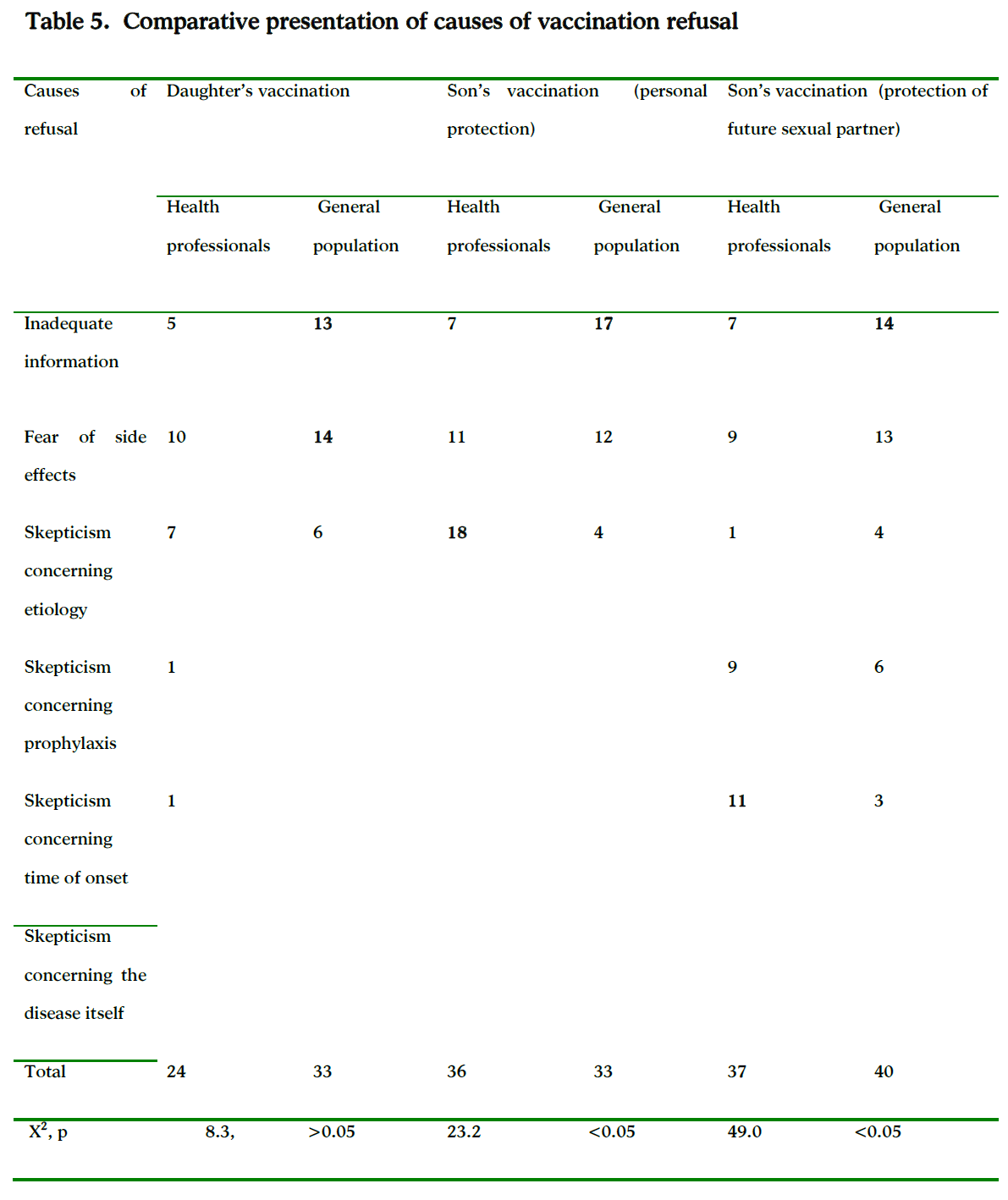
According to the results of the present study, 40/100 (40%) of the general population and 60/151 (39.7%) of health professionals ignored the precise purpose of Pap test (p>0.05) (Τable 3). The majority of general population women ignored the existence of HPV, 59/100 (59%) while 36 women-health professionals (24.4%) did so (Table 4).
Women in both groups were concerned about vaccine side effects regarding daughter’s vaccination. Statistically significant differences were observed in son’s vaccination for his personal protection, and in son’s vaccination in order to protect his future sexual partner. Women in Group A were, with a statistically significant difference, more cautious about the etiology of the disease (18/36,50.0%) vs women in group B (4/33, 12.1%). General population women (group B) considered themselves less informed about son’s vaccination (for personal or future sexual partner’s protection (17/33, 51.5% & 14/40, 35.0% respectively) in comparison with women in group A (7/36,19.4% & 7/37, 18.9% respectively).
DISCUSSION
According to the findings of the present study, both health professionals and women of the general population in Greek province areas are receptive to HPV vaccination. Nevertheless, they are cautious about the side effects and the aetiology of cervical cancer, while precise knowledge of Pap test purpose is rather limited in both groups.
A comparative assessment of the women’s answers in both groups revealed that health professionals differed statistically significantly from the general population in the knowledge HPV existence and were more receptive to their offspring’s HPV vaccination. However, about 25 % of them were opposed to their offspring’s vaccination and similar percent have never heard of HPV. This finding is in accordance with the results of international studies showing that despite their limited knowledge on HPV, women are receptive to HPV vaccination with health professionals being more receptive [13,14]. According to an online survey conducted on behalf of Wall Street Journal, the majority of parents were in favor of their daughter vaccination, while 32% were indecisive and 6% absolutely negative [15]. Women of Latin origin seem more receptive [16]. Gynecologists appear to have the best knowledge regarding HPV, cervical cancer pathophysiology and epidemiological features, while general practitioners and pediatricians are less aware of the disease and its prevention capabilities [13-17].
Health professionals and women of general population raised different reasons for not taking the vaccination. Lack of adequate information were put forward by health professionals, while scepticism about the aetiology and fear of side effects by general population women. The same reasons are proposed in international studies as well. Women demand precise and thorough information about short and long term effects of the vaccine [18,19].
Both groups seem to ignore the precise purpose of Pap test. Despite the fact that Pap test is used worldwide for decades, precise knowledge of its purpose is lacking. About one third of women aged 25-54 years old in the outpatients’ department of hospital in Chili, knew that Pap test was conducted in order to detect neoplasia, whereas most women knew it had something to do with the genitals [18]. In a study that compared the knowledge of women in Greece and Finland in regard to the Pap test, it was found that even though the general level of knowledge was similar (<50%), the level of knowledge of the women in Finland was significantly higher [20]. In the countries of the so called Third World, the picture seems to be worse, even among University students and health practitioners with nurses being less aware of Pap test capabilities in comparison to doctors [7,21]. Even in developed countries, where doctors report a satisfactory knowledge of cervical cancer prevention capabilities, practical implementation is somewhat confusing [13,17].
Health professionals and women of general population often neglect taking the Pap test. A previous research conducted in Greece, also found that 25% of the women (average age of the sample was 42 years old) had never done a Pap test in their life [21]. The lack of an nationally organized prevention program may have contributed to these disappointing results.
Although health professionals were more receptive to vaccination, a lot of them were not fully aware of Pap test purpose or HPV existence. This fact raises concerns about the efficacy of cancer prevention policy in Greece and the efficacy of public health sector in general. The curriculum of medical and nursing studies should be reviewed in order to provide up-to -date information and facilitate students in assessing current prevention practices available worldwide. Continuous education for nurse practitioners should be encouraged. A misinformed health professional could hardly serve his/her mission and, moreover, could be harmful to the public. Insufficiency of public health services together with lacking of nationally organized prevention programs could account for the low receptivity of general population sample.
Conclusions
In conclusion, women health professionals and women of general population of province areas and of similar socioeconomic status have a fragmentary knowledge regarding test Pap, while they are both receptive to HPV vaccination. The small sample size should be taken into account when interpreting these results. The ethnicity/place of origin of the women was also not asked. The relative consistency of our findings, however, with those of international studies indicate the disappointing picture regarding prevention strategies and raise questions about health professionals’ training issues.
5298
References
- Arbyn M, Raifu AO, Autier P, Ferlay J. Burden of cervical cancer in Europe: estimates for 2004. Ann Oncol 2007;18:1708-15. 2. Davies P, Bogdanovic-Guillion A, Grce M, Sancho-Garnier H The future of cervical cancer prevention in Europe. Coll Antropol 2007;31:11-6.
- Paavonen J, Naud P, Salmerón J, Wheeler CM, Chow SN, Apter D, et al .Efficacy of human papillomavirus (HPV)-16/18 AS04-adjuvanted vaccine against cervical infection and precancer caused by oncogenic HPV types (PATRICIA):final analysis of a double-blind, randomised study in young women.Lancet 2009 ;374:301-14.
- Anttila A, Ronco G, Clifford G, Bray F, Hakama M, Arbyn M, et al.Cervical cancer screening programmes and policies in 18 European countries.Br J Cancer 2004;91(5):935-41
- de Carvalho NS, Teixeira LM, Pradel EM, Gabardo J, Joly C, Urbanetz AA. Vaccinating against HPV: physicians' and medical students' point of view.Vaccine 2009;27(20):2637-40.
- Donders GG, Gabrovska M, Bellen G, Van Keirsbilck J, Van Den Bosch T, Riphagen I, et al. Knowledge of cervix cancer, human papilloma virus (HPV) and HPV vaccination at the moment of introduction of the vaccine in women in Belgium. Arch Gynecol Obstet 2008;277(4):291-8.
- Arillo-Santillán E, Lazcano-Ponce E, Peris M, Salazar-Martínez E, Salmerón-Castro J, Alonso-De Ruiz P. Knowledge of health professionals about the prevention of cancer the cervix. Alternatives to medical education Salud Publica Mex 2000;42(1):34-42
- Davim RM., Torres GV., da Silva RA., da Silva DA. Knowledge of women about the Pap test in a basic health unit in Natal/RN, Brazil. Rev Esc Enferm USP 2005;39(3):296-302
- Lin SJ. Factors influencing the uptake of screening services for breast and cervical cancer in Taiwan. J R Soc Promot Health. 2008;128(6):327-34
- Gesouli-Voltyraki E, Tsetsekou E, Metaxa A, Borsi A, Noula M. The knowledge of women in a Greek Province regarding the cervical cancer, its prevention capabilities and the Pap test. H S J 2010;4(2):101-109
- Gesouli-Voltyraki E, Tsetsekou E, Marneras X, Krapis K, Ifantis A, Noula M. HPV vaccination acceptance among women in Greek provincial areas. ARCHIVES OF HELLENIC MEDICINE, 2010;27(3):522-528
- Daley MF, Liddon N, Crane LA, Beaty BL, Barrow J, Babbel C, et al. A national survey of paediatrician knowledge and attitudes regarding human papillomavirus vaccination. Pediatrics 2006;118:2280–9.
- Klug SJ, Hukelmann M, Blettner M. Knowledge about infection with human papillomavirus: a systematic review. Prev Med 2008;46(2):87-98
- Website : Wall Street Journal on line https://www.harrisinteractive.com/news/allnewsbydate.asp?NewsID=1080, Retrieved 6/5/07
- Watts LA, Joseph N, Wallace M, Rauh-Hain JA, Muzikansky A, Growdon WB, et al. HPV vaccine: A comparison of attitudes and behavioural perspectives between Latino and non-Latino women. Gynecol Oncol. 2009;112:577-82.
- Duval B, Gilca V, McNeil S, Dobson S, Money D, Gemmill IM, et al. Vaccination against human papillomavirus: a baseline survey of Canadian clinicians' knowledge, attitudes and beliefs. Vaccine. 2007;25(45):7841-7
- Lamadrid A S. Knowledge and fears among Chilean women with regard to the Papanicolaou test. Bull Pan Am Health Organ. 1996;30(4):354-6
- Nganwai P, Truadpon P, Inpa C, Sangpetngam B, Mekjarasnapa M, Apirakarn M et al. Knowledge, attitudes and practices vis-a-vis
- cervical cancer among registered nurses at the Faculty of Medicine, Khon Kaen University, Thailand. Asian Pac J Cancer Prev 2008;9(1):15
- Iatrakis G, Zervoudis S, Peitsidis P, Nikolaki MM, Biba D, Sotiropoulou E.Knowledge and general consideration about Pap test screening among women from Finland and Greece.Clin Exp Obstet Gynecol. 2008;35(3):211-4.
- Akujobi CN , Ikechebelu JI , Onunkwo I, Onyiaorah IV. Knowledge, attitude and practice of screening for cervical cancer among female students of a tertiary institution in South Eastern Nigeria. Niger J Clin Pract. 2008 ;11(3):216-9.
- Paraskevopoulou E, Economou A, Panagopoulos P, Zikopoulos M, Petrakos G, Koutras I. Cervix cancer scree.ning among Greek and immigrant women: the experience of a Greek District Hospital. Clin Exp Obstet Gynecol. 2005;32(1):52-4










